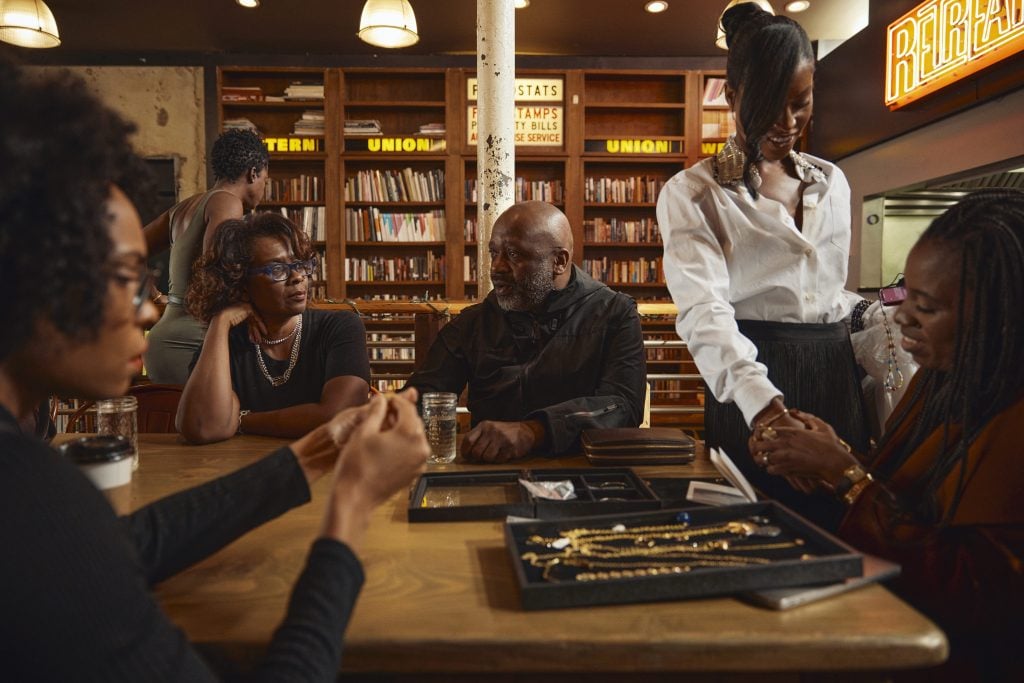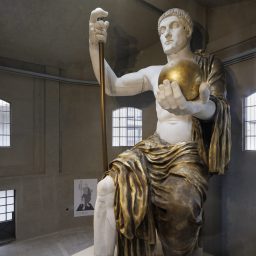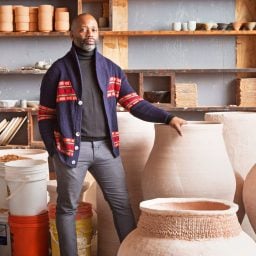Theaster Gates currently has a lot of plates spinning, from his recently unveiled Serpentine Pavilion, Black Chapel (through October 16, 2022), in London, to an upcoming survey exhibition—his first—at the New Museum in New York (November 10, 2022–February 5, 2023). In between, the artist’s nonprofit Rebuild Foundation just broke ground on its largest community arts project to date: transforming the former St. Laurence Elementary School on Chicago’s South Side into a 40,000-square-foot incubator for artists and creative entrepreneurs of color.
Two years after the murder of George Floyd, while companies have gone quiet on their diversity declarations and Black Lives Matter street art has been fading (if not erased), Gates has only ramped up his commitment to the neighborhood where he was born and is still based, and where he began as a humble potter before moving into social practice, sculpture, and performance.
Central to Gates’s mission is driving revitalization in underserved communities through creative industry—whether locally, by using his studio as an umbrella for a design-and-manufacturing arm called Dorchester Industries, or globally, by serving as co-chair of the Diversity and Inclusion Advisory Council for Italian fashion giant Prada. Last September, the house announced a partnership with Gates and Rebuild to further address inequities across the design world: the Dorchester Industries Experimental Design Lab (EDL), a three-year program to support and amplify the work of emerging creators of color.
Nominated by luminaries from across the creative industries, including Ava DuVernay, David Adjaye, the late Virgil Abloh, and Miuccia Prada herself, the first EDL awardees are an international cohort whose fields range from fashion to food. They include choreographer Kyle Abraham, urban farmer Yemi Amu, artist and designer Salome Asega, architect and designer Germane Barnes, artist and designer Brandon Breaux, chef Damarr Brown, fashion designer Tolu Coker, graphic designer Summer Coleman, visual artist Kenturah Davis, architect Mariam Issoufou Kamara, designer and educator Maya Bird-Murphy, shoe designer Kendall Reynolds, jewelry designer Catherine Sarr, and product designer Norman Teague.
As disparate as their practices may seem, the 14 EDL awardees—and Gates—all share a dedication to serving communities of color. Gates made time to speak with Artnet News about teaming up with Prada, what diversity in design actually means, and the creative hub that he is cultivating on Chicago’s South Side.
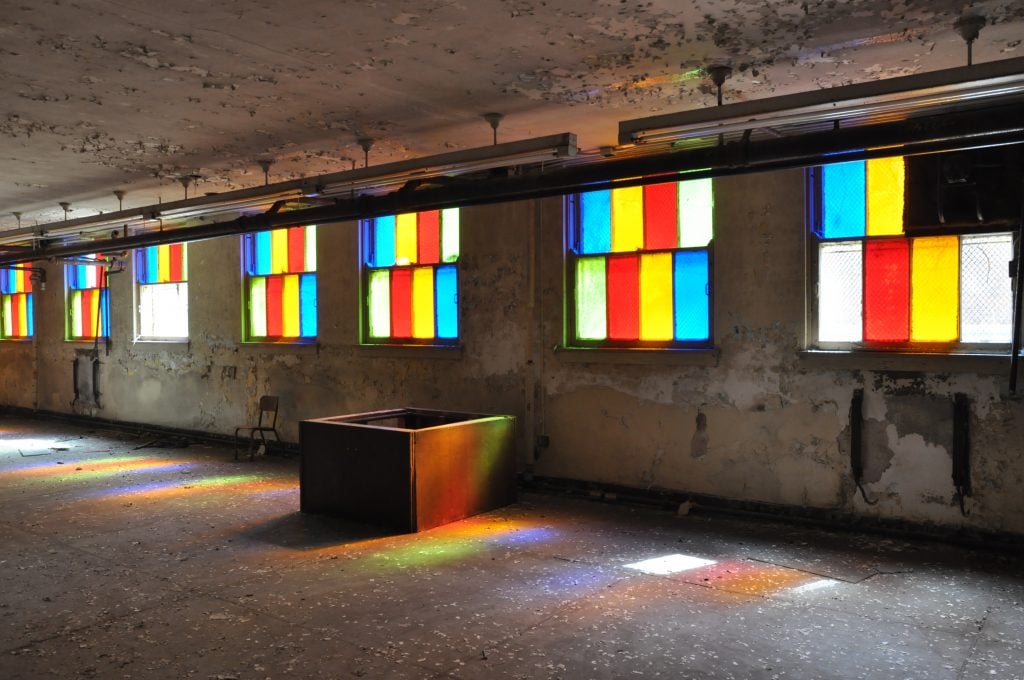
Inside the St. Laurence Elementary School, which Gates and his nonprofit Rebuild Foundation are turning into an incubator for artists, designers, and creatives of color on Chicago’s South Side. Photo: Sara Pooley.
The worlds of art and design have been overlapping more and more lately. You’ve been inhabiting and shaping the space between them for a long time, of course. Why do you gravitate towards this gray zone?
Well, I’ll tell you the truth. The truth is that the art world—as proud as I have been to participate in it, and of the many blessings that it’s given me in terms of life experience and lifestyle—it’s a zone that not everyone has an opportunity to participate in.
I think the design field is a much more generous and generative field, where the activity that creatives are involved in could have a different kind of everyday impact on the world, you know? And I’ve found that the only real difference between artists and designers is how, or into which markets, we choose to apply our skill sets.
Not everyone is made to be a great painter, but some people can use an interest in painting to be a designer. In some ways, design completes the world of creativity and the world of the imagination. And so it feels really good and quite natural that artists are deepening their adjacencies to fashion and furniture and interiors and architecture.
It seems like all of the borders are a bit permeable right now—it’s like this moment of boundary-less-ness. Consider the ways in which gender and sexuality are being queered. It’s like we’re in a moment in the evolution of our intelligence, of the way that we think, where predeterminations and over-descriptions are boring.
We’ve gotten to a point where we don’t have to be so absolute in our vocation or overdetermined in our pursuits in life. We can live at edges and borders and cross in and out of things; we can be more flexible and fluid.
While I don’t call myself a designer, there are definitely times where within my art practice, I feel like I’m solving the problems of design.

Theaster Gates’s structure for the Serpentine Pavilion in London, Black Chapel (2022), the first commissioned from a non-architect. Photo: Iwan Baan. Courtesy of Theaster Gates Studio, Serpentine.
You’ve been doing this work with Prada since at least 2019, when you became the co-chair of its Diversity and Inclusion Advisory Council. How did your partnership first come about?
So, it’s really grown out of a personal relationship with a very special lady. When I first met Miuccia [Prada], which was at Ronnie Scott’s [Jazz Club in London]—she came to hear the Black Monks in, like, 2012—I didn’t know who she was. This really nice Italian woman kissed me on my cheeks and said that she enjoyed the performance.
But over the years, as we got to know each other, I found myself really inclined toward her knowledge of art and politics, her belief in artists and celebration of them through the foundation, but also the history of alliance that she’s had with great Italian artists, especially those from Arte Povera. And, you know, we just became friends.
And over time, it was me saying, “Miuccia, is there anything that I can do to, you know, help?” And she said, “No, no, no, no. We can have exhibitions and leave the corporate stuff aside.” You know? “The business is fine.”
And [I kept] pushing in and saying, “I think that there are ways to help.”
So when they decided to take the diversity initiative on in a more strategic way [by launching the Prada Diversity and Inclusion Advisory Council in 2019], I was very, very excited to be considered for that.
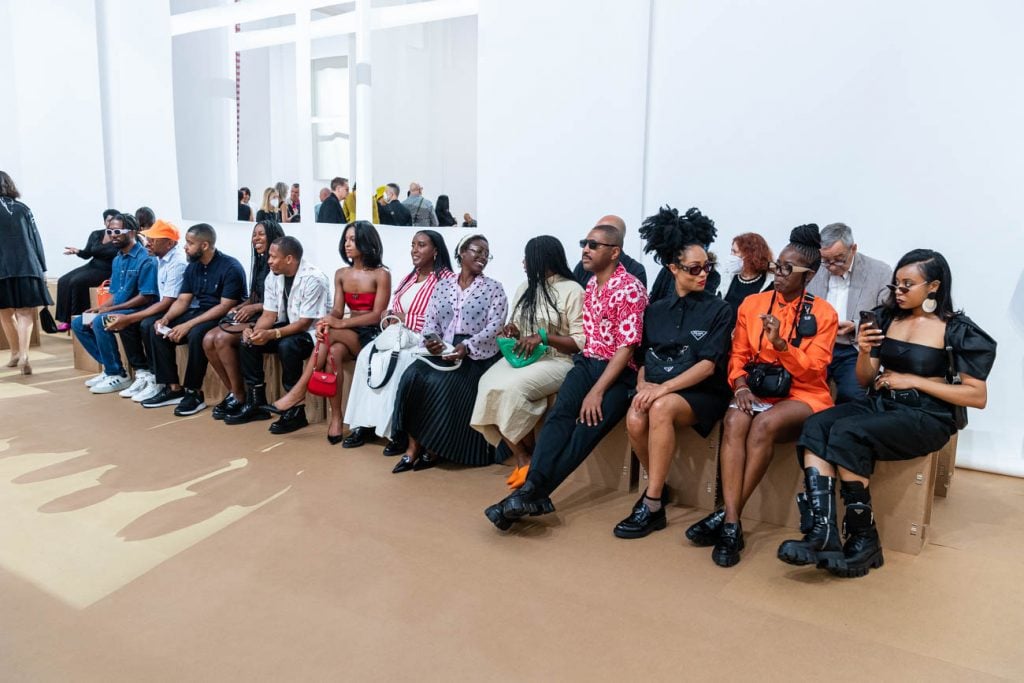
Members of the Dorchester Industries Experimental Design Lab inaugural cohort, front row at the Prada Men’s spring-summer 2023 fashion show in Milan. From left: Brandon Breaux, Norman Teague, Damarr Brown, Maya Bird-Murphy, Germane Barnes, Kendall Reynolds, Salome Asega, Yemi Amu, Mariam Kamara, Kyle Abraham, Kenturah Davis, Summer Coleman, Tolu Coker. Photo: Getty Images.
What drove you to create the Dorchester Industries Experimental Design Lab (EDL) with Prada last fall?
There has never been a shortage of design talent in communities of color, there has only been a lack of visibility and opportunity. I feel very fortunate to have a platform to celebrate and amplify the work of designers doing amazing things, and I’m dedicated to turning excess into access where and when possible.
After the murder of George Floyd and the country’s latest reckoning with racial injustice, Miuccia and I discussed how the company could acknowledge the need for growth, given the challenges of representation and diversity in the fashion industry. We explored how we might create opportunities to amplify the work of artists and designers [of color]. Through these conversations, the Dorchester Industries Experimental Design Lab was born.
What’s your vision for it?
My biggest ambition for this program is to provide the resources necessary for this group of tremendously talented designers to create limitlessly, unencumbered by financial restrictions that may inhibit their creative processes and innovation.
I hope that the Experimental Design Lab becomes both a platform and a pipeline for exceptional designers of color to be acknowledged for their brilliance and considered for opportunities at the top levels of creative collaboration. I hope it opens doors for an entire generation of designers and encourages leading corporations to invest generously in their ideas, their work, and their practices.
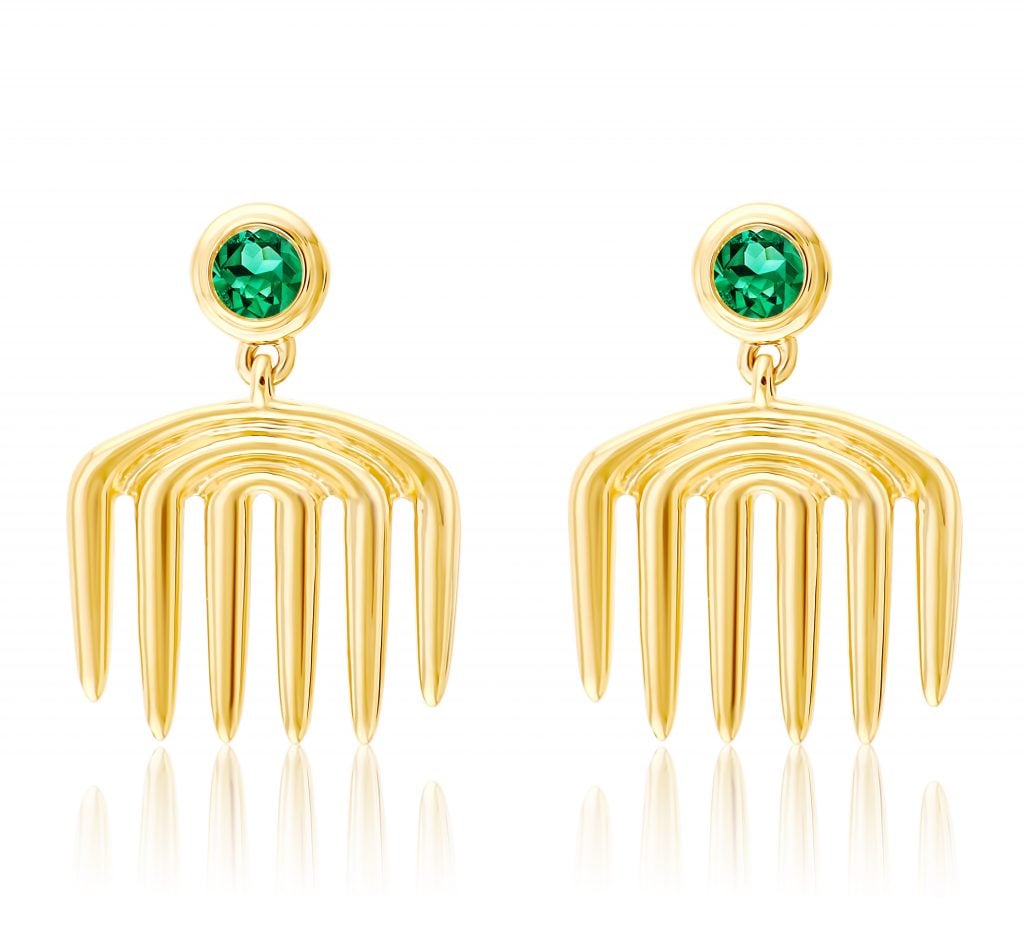
18-karat gold and tsavorite Vici earrings from Almasika’s Sagesse collection, designed by EDL awardee Catherine Sarr. Courtesy of Catherine Sarr and Almasika.
The first cohort of awardees has a wide range of disciplines, from fashion to food. Was there something you sought out, like a common approach?
Something that was not part of the criteria per se, but that showed up in the awardees’ work across the board, was a commitment to or deep care for the communities they are from.
You know, Yemi [Amu] is pursuing histories of agriculture within her family, and thinking about the ways in which Black people have been connected to the soil for forever, but also training up young farmers from all backgrounds with her aquaponic farm in Brooklyn. So something that’s very personal becomes a way of engaging others. Then that thing turns into a market, and there’s free food given to community members. It has its own immediate me-we built into it.
The same with Maya [Bird-Murphy], a person who’s essentially crowdsourcing problems within the Black community here in Chicago and trying to solve those problems in really creative ways—by having a mobile design center so that she can take design on the road and share it with kids in communities who may not normally have access to a world like that.
On the other end of the spectrum, we have designers like Kendall Reynolds. She’s interested in high-end luxury shoes, but acknowledging the fact that a Black woman wants to look good when she goes out on the spot, and that, like, her toes need to be done. And it’s like full admission of the kind of beauty and sexuality and mystique and seduction of Black women, and really celebrating that, and creating another kind of community via Instagram, so that there’s a woman who feels like she has the right to be seen because there’s a Black woman making shoes for her, you know?
Norman Teague, he’s training a whole generation of young, Black and brown designers out of his studio. So people have their work that they’re doing, but they’re also deeply committed to education, to passing it forward, to their excess becoming something that is available to the community. All of those things make me very, very honored to work with them.
I’m eager to see how their approach to their own work is enriched by the encounters they have with their fellow cohort members, design leaders across the artistic industries, and corporations—like Prada—who are committed to investing in the next generation of diverse talent. I’m eager to see what these connections give birth to.
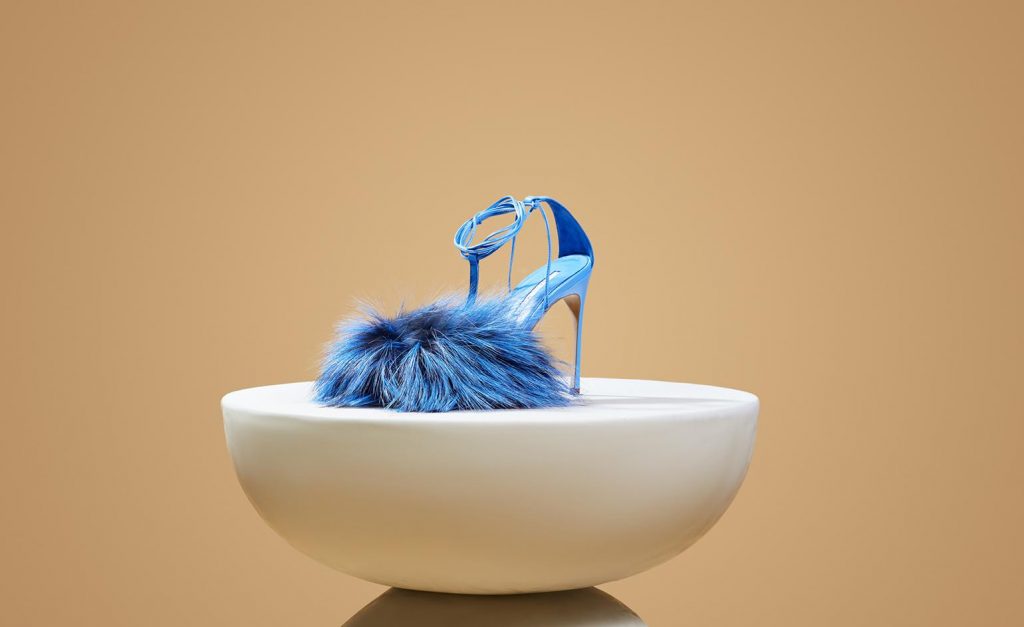
Kendall Miles Foxxy sandal, designed by EDL awardee Kendall Reynolds. Photographer: Sam Kfare. Courtesy of Kendall Miles Designs.
How do the challenges they have faced compare to those you encountered as a Black man coming up in the art world?
It goes without saying that historically, designers of color have disproportionately lacked access to investment, representation, and opportunities for professional advancement compared to their white counterparts. There has [also] been an institutional reluctance to take risks by investing in designers who create and innovate against the norm.
I think that as I was honing my vision and practice, the design world began to take note of the innovative ways that Black artists were challenging what it meant to be a creative person. Our work—informed by underappreciated histories, cultures, and modes of reasoning—interrogated existing systems of representation and unapologetically demanded awareness.
We are now living in a moment where Black artists create demand and move the culture, but we still haven’t developed effective pipelines for recognizing, valuing, and honoring young designers of color to the extent their work demands.
The term “design” has been so narrow for so long, I think we forget that we are designing every day. There are creative people who are approaching common challenges with fresh solutions that step slightly outside the box of what design has traditionally meant, and they deserve to be supported and celebrated just as much as those who are staying within defined guardrails. Design only stands to benefit from the explorations of their practices.
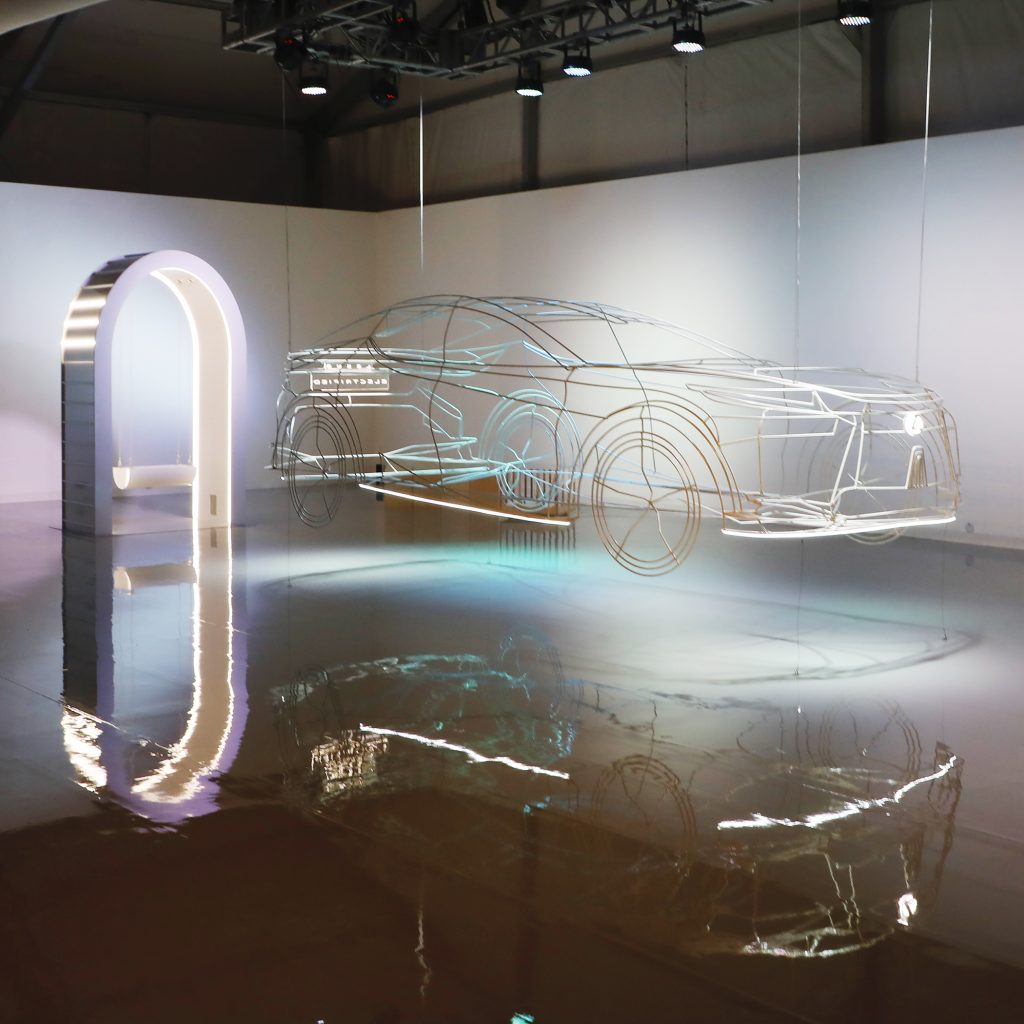
An installation by architect, designer, and EDL awardee Germane Barnes and the University of Miami, presented by Lexus for Design Miami 2021. Courtesy of Germane Barnes.
What does “design” mean in your mind, or what’s your expanded conception of it?
If we look at, say, the history of design after World War II, when you think about Charles and Ray Eames, or Italy’s pursuit of design as a state project, you realize that design was in some ways an aestheticized and political agenda to make good use of technologies that existed, technologies that could benefit the common person. The reason I say ‘aestheticized’ is because it meant—and this is to the narrow part—that it gave design a name and a style, and it had gatekeepers.
But adjacent to the more formal, postwar canonization of design, there were also people who had lived in the South and were constantly creating new technologies for farming and agriculture. There were people who worked in factories who were making assembly lines work better—because they were on the assembly lines every day, solving problems that only you could solve by being on the assembly line.
There were people at their homes and, in some cases, in their poverty, or even people like George Washington Carver, in their intelligence and genius, who were attempting to solve life’s everyday problems without the title of “design” adjacent to their names.
I would say my mom and my grandmother were always solving problems, making our clothes and our coats, pot warmers and table protectors, fixing and repairing and mending—but nobody would ever call my mom a designer for making a doily, although my mom was extremely creative, you know?
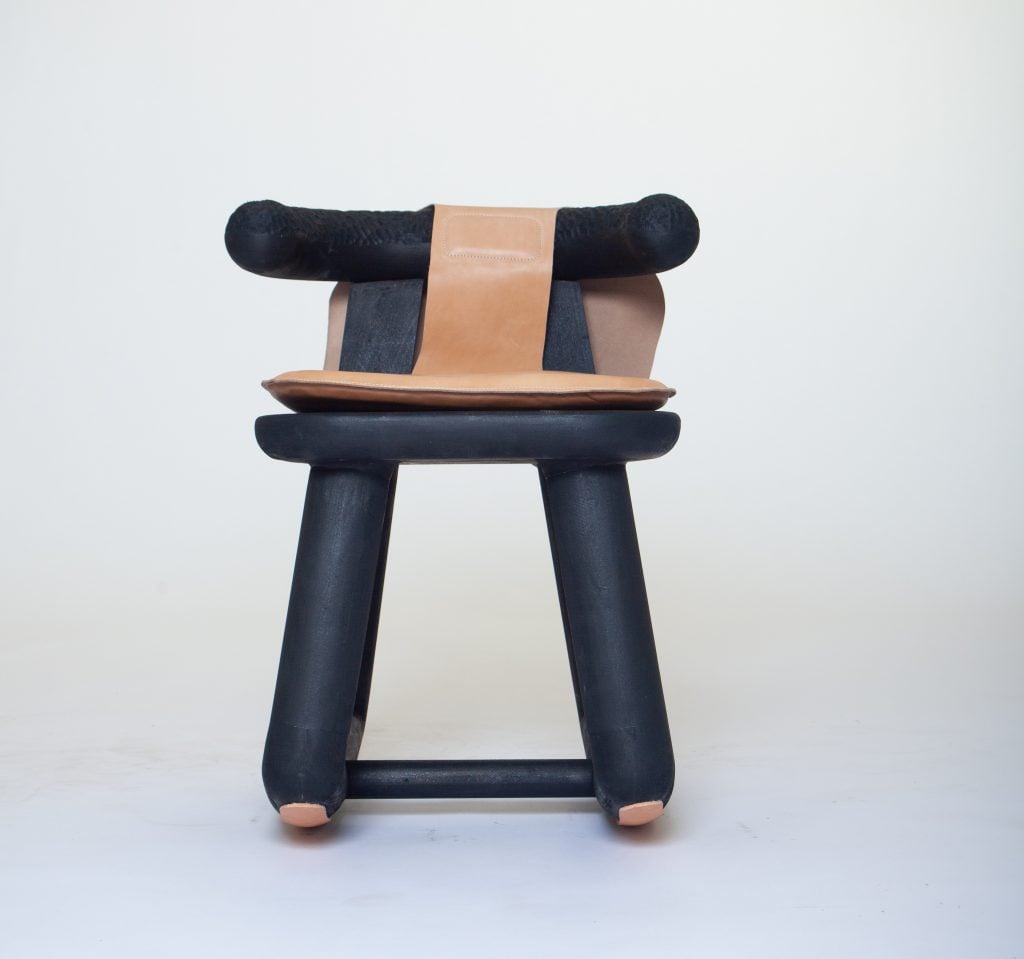
Solid basswood “Africana Chair” with leather seat by Yohance Lacour, designed by EDL awardee Norman Teague and produced by Norman Teague Design Studios. Courtesy of Norman Teague.
How do you think the role of a designer should be defined going forward?
Two things seem important for the future: One is that people expect more from design—they expect more from their fashion, from their shoes. And that more is going to require that we expand who designers are, where design comes from, and how design is made.
And secondly, while we make tremendous strides in terms of synthetic materials and machine-applied technologies that will allow us to make a shoe better or a purse stronger or Lycra more elastic, we still need the people who make decisions about how to dress the body, how the body should feel in a chair, how a spoon should feel in one’s mouth, how curlers and hair clippers should feel against the head.
While there’s a lot that technology can do, there’s still the need for that work—for touch and reflection and error and failure and trial. And I think that requires people who have been on the margins—who I feel have a deep understanding of the problems of life, because they touch those problems more frequently than others.
The idea that the future needs people who are solving more and more complicated problems is exciting. What I’m hoping for is a mix of people who understand deeply the kind of academic rigors of design and people who also understood at an intuitive level that design is simply the effort of solving problems beautifully.
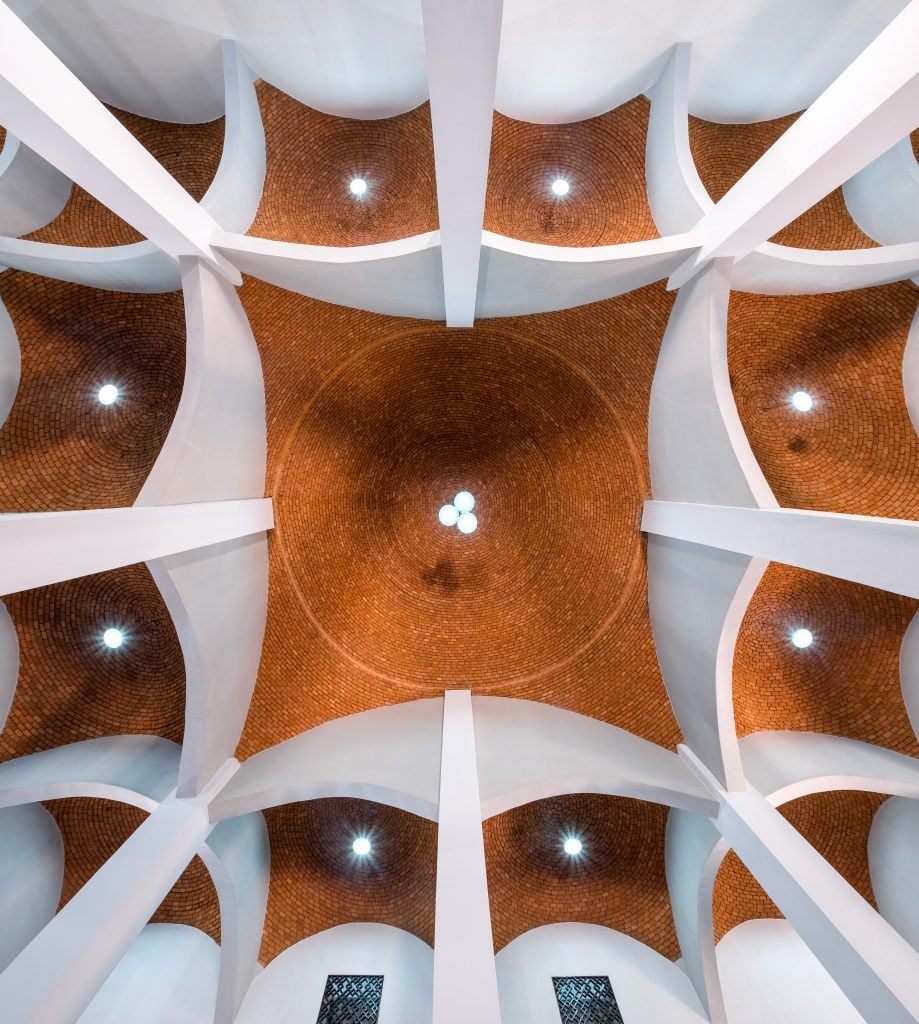
Hikma Religious-Secular Compound in Dandaji, Niger, designed by architect and EDL awardee Mariam Kamara’s Atelier Masomi. Photo: James Wang. Courtesy of Atelier Masomi.
The Experimental Design Lab is based in Chicago’s South Side, where you’ve made a practice of turning abandoned buildings into cultural institutions for the local community.
The Experimental Design Lab inhabits the spaces that artists are working in globally—from Niger to New York and London to Los Angeles. It’s both a concept and a cohort as much as it is a place.
Our team at Rebuild Foundation has begun remediating the former St. Laurence Elementary School on the South Side. Once complete, this 40,000-square-foot space will become a creative entrepreneurship incubator, housing artist studios, makers space, and Rebuild Foundation’s archives, and will keep rising artists in the community.
In the meantime, our designers will have access to the spaces and collections across our sites to discover inspiration for new work and [to connect with] the cohort and the South Side community.
How do you see the city evolving with the Experimental Design Lab? What’s your hope for the future?
When most people think about Chicago, they don’t immediately think about the city being a hub for design intelligence. I am committed to changing that.
The Experimental Design Lab will expand the notion of what it has traditionally meant to be a designer, enhance the profile of design in Black space, and cultivate a nucleus of design energy on the South Side.
More than half of the designers in this group are either from or currently reside on the South [Side] and West Side of Chicago, so we aren’t just bringing the design industries to Chicago—we are bringing Chicago to design.
